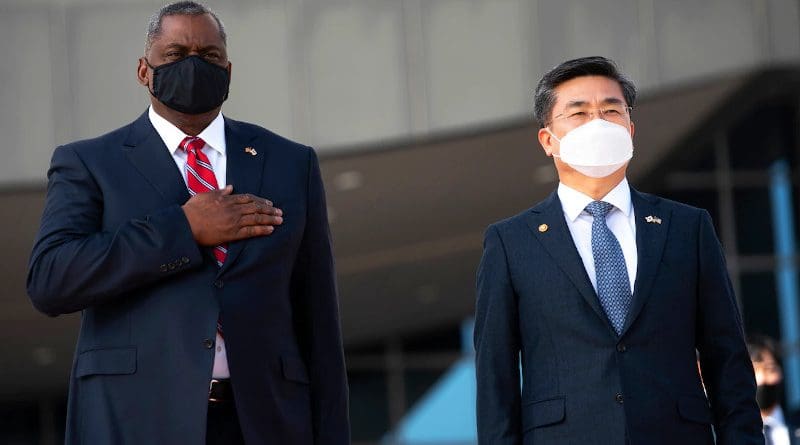US, South Korean Defense Leaders Plan For Future Of Alliance
By DoD News
By Jim Garamone
Secretary of Defense Lloyd J. Austin III reiterated America’s ironclad commitment to the defense of the Republic of Korea in his first face-to-face meeting with South Korean Minister of National Defense Suh Wook today in Seoul.
The alliance was signed in 1953. South Korea had endured invasion and combat on its soil with millions of its citizens killed.
The United States as part of the United Nations effort came to the aid of the nation. The peace and security that followed the armistice enabled the Republic of Korea to rebuild its nation and forge ahead to become a democracy and an economic powerhouse.
Austin said South Korea is “the linchpin” of peace, security and prosperity for Northeast Asia. “Our alliance is founded on shared interest and values and is among the most combined, interoperable, capable and dynamic bilateral alliances in the world,” he said at the beginning of the meeting. “The ROK is also a critical partner for our shared priorities in the region. The principle among them is upholding the rules-based international order. You have become a key provider of security and stability in the Indo-Pacific region, and for that we are grateful.”
The two defense leaders met on the eve of a larger meeting called the “Two-plus-Two” with Austin and Suh being joined by Secretary of State Antony J. Blinken and Minister of Foreign Affairs Chung Eui-yong. It is a measure of the importance of the region and the friendship between the two countries that these meetings take on added significance, said a senior defense official. This is the first official overseas trip by both Blinken and Austin.
Wednesday’s meeting concentrated on the military portion of the alliance. The two leaders reviewed the situation with North Korea, including the threat posed by North Korea’s nuclear and missile programs, said the senior defense official. Both men agreed that this threat requires the continued vigilance of the alliance.
The alliance grew out of the Korean War and in the initial part of its history, was almost totally focused on deterring North Korea. While North Korea remains a threat, as South Korea rebuilt and became a regional power, the focus of the alliance has expanded to include the region. The two leaders spoke about the regional security environment beyond the Korean peninsula. These included China’s actions to overturn the current rules-based system that has served the region so well since World War II, the official said.
This broader regional focus means increasing the contact and interaction between the US-South Korea Alliance and other like-minded partners. The defense leaders spoke about the trilateral relationship among the United States, South Korea and Japan. They also spoke about cooperation with nations such as Australia, India, Malaysia and others. Engaging in multilateral relationships would allow the nations of the region to build a network dedicated to supporting the rule-based system in the Indo-Pacific, the official said.
Austin also spoke frankly with his South Korean counterpart about the administration’s Korean policy review. He wanted to consult with Suh because the secretary wants to get his observations, thoughts and input into that process.
The two men discussed the readiness of the forces in South Korea especially in light of the COVID-19 pandemic. They discussed ways to increase readiness overall, and looked at the exercise program.
The North Korean border is just miles from the heart of Seoul. Long-range artillery, alone, could reach this vibrant city of 10 million.
There are 28,000 American service members assigned in South Korea ready to help that country “fight tonight” if need be. There are many, many more on call, if the North tries to duplicate 1950.

